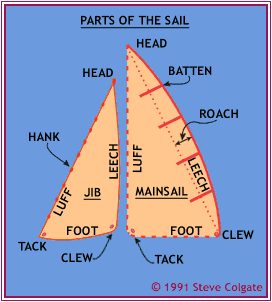
|
|
||||||
The Hull of the boat is the frame which keeps the boat and its crew floating in the water. The mast is the tall pole that sits vertically near the center of the hull, the mast is what the sails are attached to to keep them suspended and straight. The boom is a large pole attached to the bottom part of the mast which is able to rotate up, down and side to side. The sails attach to the boom and the mast then the person controlling the main sail moves the boom around to change the direction and tension in the mainsail.
The rudder is atached to the rear of the boat and is what essencially steers the boat (note that the rudder alone will not steer the boat exactly where you want to go in a sailboat unlike other motorboats).
The most difficult part of a sail boat for most beginners to understand is the keel or centerboard. The keel of the boat does many things, it acts as a pivital point for sharp turns and "jibbing", it helps keep the boat upright by lowering the center of gravity of the boat, it works to keep the boat moving in a line of motion close to that of the direction that the boat is facing. This is because the boat is usually being pushed heavily to the side by the wind. And the keel also works to pull the boat into the direction of the wind the same way the sails do. This is a concept that I will discuss later on.

The main parts of the sails that are important to remember are the head, the tack, the foot, the leech and the clew. These are in the following picture to the right.